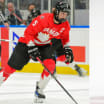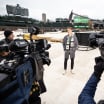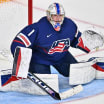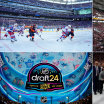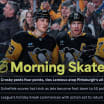Goaltending is an integral part of the Stanley Cup Playoffs. We've charted the last 50 goals allowed by each goalie in the regular season and every goal in the postseason, with the help of Apex Video Analysis and Save Review System from Upper Hand Inc., to see what patterns emerge.
Vasilevskiy vs. Khudobin goalie matchup in Stanley Cup Final
Lightning-Stars first championship round with starters who played for Russia
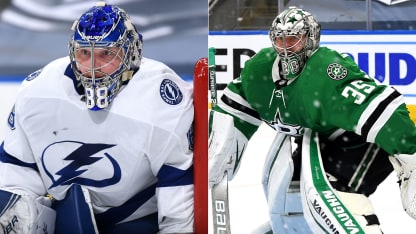
By
Kevin Woodley
NHL.com Independent Correspondent
For the first time in NHL history, the 2020 Stanley Cup Final will involve two starting goalies who have represented Russia internationally when Andrei Vasilevskiy of the Tampa Bay Lightning opposes Anton Khudobin of the Dallas Stars.
Khudobin, who was born in Kazakhstan, and the Russia-born Vasilevskiy are each known for acrobatic, athletic saves, but the comparisons end there. From size to style to positioning, their approaches are very different and require different methods of attack to avoid strengths and attack weaknesses in the best-of-7 series when it begins at Rogers Place in Edmonton, the hub city for the Final.
Game 1 is Saturday (7:30 p.m. ET; NBC, CBC, SN, TVAS).
RELATED: [Complete Stanley Cup Final coverage]
ANDREI VASILEVSKIY, TAMPA BAY LIGHTNING
There aren't a lot of glaring weaknesses for Vasilevskiy, who is again a Vezina Trophy finalist one season after winning the award for the first time. He's had an impressive postseason (14-5-0 with a 1.82 goals-against average and .931 save percentage) to help the Lightning become the only team to advance to a conference final without needing to start a second goalie or play a Game 7. With explosive movement added to a solid technical foundation, Vasilevskiy has established himself as one of the best goalies in the NHL, but there are trends that can be targeted.

Goal trends
Get him on the iron: Post integration played a role in 20 percent of tracked goals in the regular season, nine of 40 in the postseason (22.5 percent), and the New York Islanders seemed intent on targeting it in the Eastern Conference Final, scoring three times in those situations. That included Devon Toews' wraparound goal in Game 6, and a low-high pass out to Anthony Beauvillier in Game 3. It doesn't always have to be attacks from the goal line either. Vasilevskiy tends to stay on his post and sit in reverse-VH, a tactic in which the short-side pad is along the ice against the post and the back pad is up and that skate is used to push his body into the post and pivot around it, even after the puck moves away from a sharp angle, or sometimes before it gets there. The tendency cost him on a shot from the hash marks along the boards against the Columbus Blue Jackets. Islanders forward Brock Nelson caught him leaning into his post with a Game 3 shot from above the bottom of the face-off circle, and it can also delay his movements getting off the post to quick shots.
Against the grain: As quick as Vasilevskiy is, he still gets caught in motion rather than beating plays and getting set. It shows up in his goal totals on shots directed against the flow. Thirty percent of his regular-season goals came on shots against the grain, almost double the 17.7 percent average for more than 6,000 goals tracked during four years of this project, and the Islanders scored five of their 11 goals (45 percent) in the series in this manner.
Looking over traffic: Vasilevskiy has always tried to look over screens rather than around them, almost standing straight up like he's on tippy toes. A late transition to the ice didn't cost him as many goals along the ice as past seasons, but he can get caught dropping from that high stance with shots back up high, and it played a role in several of the surprisingly high 14 mid- and high-glove goals in the regular season (28 percent), and nine in the postseason (22.5 percent)
Into the body on the blocker side: Though the top corner is the target on the glove side, there's not the same need to be perfect on the blocker. Vasilevskiy has allowed six such goals (11.4 percent) among the tracked regular-season goals, more than double the 4.7 percent average. He has allowed five such goals (12.5 percent) in the postseason.
Quick releases: Lateral passes and one-timers are a good way to beat any goalie, and it may say how well Vasilevskiy is playing that it's taken those types of plays to score on him in the postseason. Quick releases and one-timers played a role in 55 percent of the goals, including seven of 11 against New York, up from 30 percent in the regular season and above the 37.4 percent tracked average.
Pucks off pads: Rebound goals weren't an issue against the Islanders but they are up in the postseason to 25 percent from 14 percent in the regular season, and Vasilevskiy's pads are designed to create active rebounds that come off hot, so forwards may want to establish position further away from crease to take advantage of those opportunities.
ANTON KHUDOBIN, DALLAS STARS
Khudobin went into the West Final with a .909 save percentage in the playoffs but looked a lot more like the goalie who led the NHL with a .930 save percentage in the regular season while saving 153 of 161 shots (.950 save percentage) against the Vegas Golden Knights. The key for Tampa Bay will be creating chances that gave Khudobin trouble earlier in the playoffs. To do that, they need to counter his strengths, which are highlighted by an ability to read plays and shot releases and using quick feet to get out past the top of his crease to make up for his 5-foot-11 height.
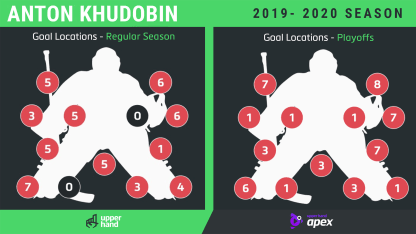
Goal trends
Layered screens and chaos: Reading plays, positional aggression and patience on his skates are hallmarks of Khudobin's game, so it's not surprising that he struggles with traffic that pushes him deeper into his crease and makes it harder to see the puck because he's not tall enough to look over traffic. His regular-season totals for goals involving screens (28.6 percent) and deflections (25.2 percent) were already well above the tracked averages for all goalies, and they jumped to 48.8 percent for screens and 31.7 percent for deflections through the first two rounds. In the conference final, Vegas scored twice with traffic and twice more on deflections but too often settled for single-player screens, which Khudobin managed to look around with relative ease. Vegas didn't create enough of the broken-play scrambles that led to goals against Khudobin earlier in the playoffs.
Rebounds, but elevate: A by-product of shots into traffic is rebounds. Khudobin will control most of the shots he sees, as evidenced by his regular-season rebound goal totals (21.9 percent) being slightly worse than the average (20 percent). Those numbers were up through two rounds of the postseason (24.4 percent), with broken-play scrambles accounting for nine of those 10 goals, but the Golden Knights didn't manage any such goals, in part because they failed to elevate some of their best chances. As Mark Stone and Alex Tuch found out after Khudobin robbed them in the final seven minutes of Game 3 with the score tied 2-2, anything along the ice gives the athletic, never-give-up Khudobin the opportunity to get a pad there.
Move him one way, shoot the other: Vegas did take advantage of Khudobin's extra movement by shooting against the grain on three of their eight goals, including a long-range Alex Martinez goal in Game 4. Catching Khudobin moving one way with shots the other way has accounted for 36.7 percent of the goals against Khudobin in the postseason, up from his regular-season total (28.6 percent), which was already well above the 17.7 percent average. Max Pacioretty beat him from distance off the rush in Game 4 with an against-the-grain shot, but hit the post, and it's not the only time he's been beat clean this way, something Tampa Bay's skilled forwards might want to target more often than Vegas.
Glove side: Of the goals Khudobin has allowed in the playoffs, 48.7 percent of them went in on the glove side, above the pad. That was well above the 29.5 percent average, after two rounds, but it was noted 13 of those 22 goals involved screens and those numbers don't represent a save percentage. Reilly Smith scored over the glove with a clean shot off the rush in Game 5, but Vegas only scored twice there in the series. Khudobin not only proved those early statistics were perhaps misleading with several tough glove saves, but also continued to catch several low shots in front of his pads with his glove rather than kick out rebounds, so blocker side might be a better option.



